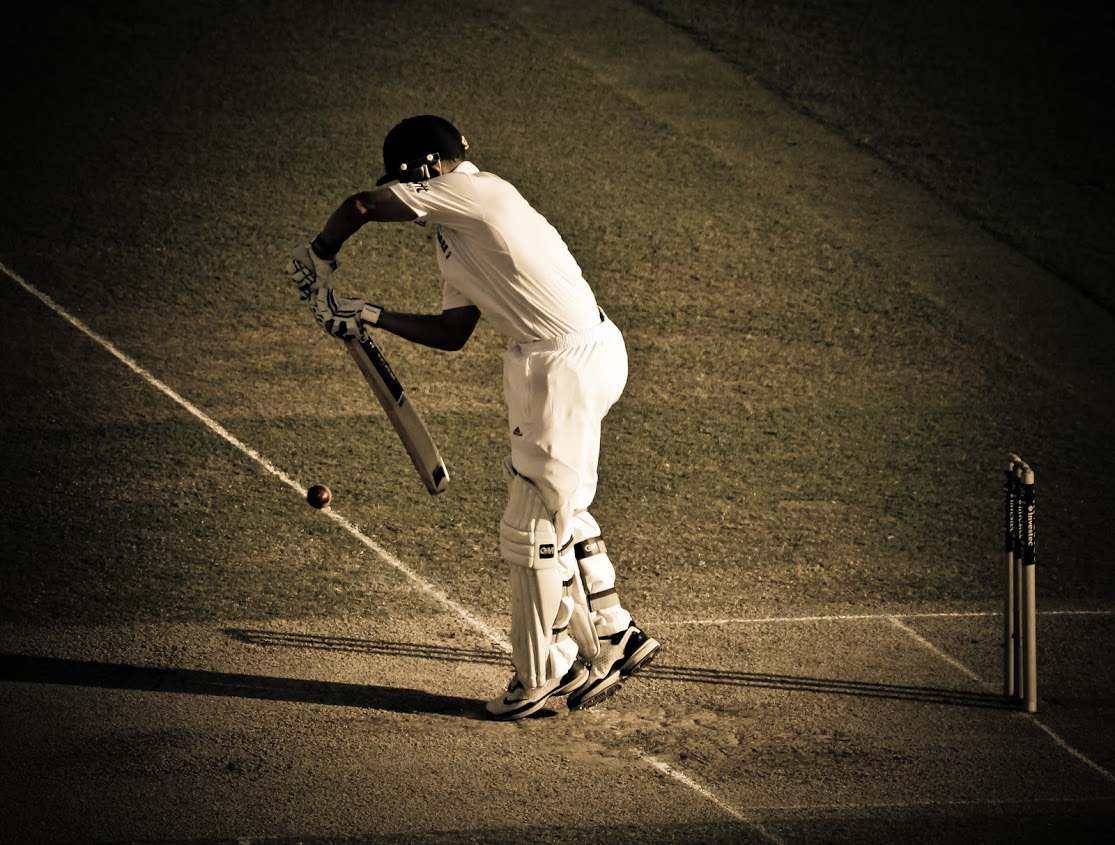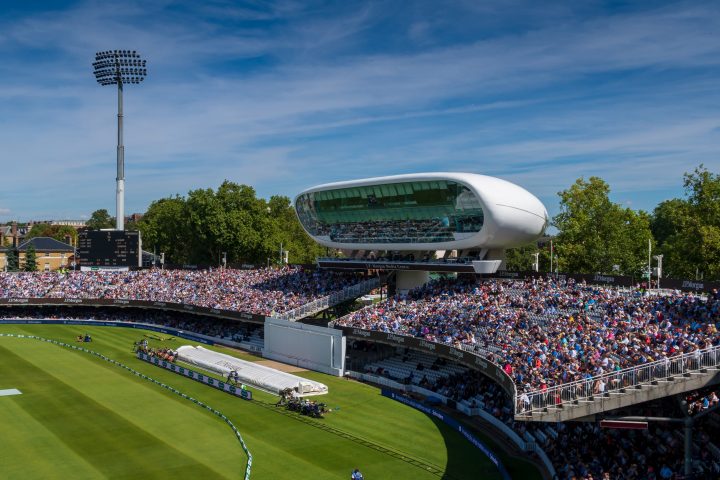
England 385, 102-4. South Africa 637,000-2 dec
Well done South Africa for an unbelievable weekend of sport. If somebody had told Nelson Mandela on Thursday morning that Ernie Els would win The Open, and that the Proteas would humiliate England at the Oval (with Hashim Amla scoring a triple hundred) he probably would have laughed. But that’s exactly what’s happened – and it’s thoroughly deserved too.
As Englishmen, we’ve usually booed South African sportsmen over the years. Guys like Corne Krige raised our blood pressure and perpetuated the rather unfair stereotype that South African sportsmen are all the same: humourless, aggressive and about as likable as Hannibal Lecter. However, the two South African sportsmen who have emerged as champions this weekend couldn’t be more likable.
Hashim Amla and Ernie Els are two of the most humble and generous people in world sport. The former is driven by an unshakable belief in Allah (and has devoted himself to a moral lifestyle), whilst Els is true gent; he almost seemed apologetic about winning at St Annes – you could see that he felt deeply for his Australian opponent, Adam Scott, who threw away victory by bogeying the last four holes. Hmmm. A South African feeling sorry for an Australian; now that really is something special.
England have no hope in hell of saving the test tomorrow, so we’re not going to bother entertaining the thought. Instead, we might as well begin the inquest now. My personal view is that South Africa deserve to be the number one side in the world. They have also beaten Australia in Australia in recent times, but they’ve played considerably better than us in the subcontinent. They also have four world class batsmen to England’s two and two halves (the halves are Trott and Bell), whilst their bowling has genuine pace and aggression (which is why they’ve got more out of this Oval surface than England).
Back in the 1990s, I scoffed at suggestions that Hansie Cronje’s team were as good as Steve Waugh’s Australians. This is because the Proteas’ game plan was often mind numbingly conservative and their plans in the field tedious to say the least. They frequently gave up trying to get batsmen out, and bowled two feet wide of off-stump in an attempt to stifle the run rate. As a result they usually strangled the life out of the game.
Andrew Strauss’ England are very similar to Cronje’s team. We are conservatism personified. Selection is always cautious – we leave out our fastest bowler despite the fact we’ve got a player as handy as Swann coming in at ten – and our only bowler with any pace in the XI, Broad, is told to bowl well within himself, stick to predetermined plans, and never use his considerable cricketing instincts. Watching England in the field is as joyless as I can remember. Bring back the halycion days of Darren Gough and Dominic Cork – guys who snarled at the batsmen and tried every trick in the book to squeeze out a wicket.
England’s current plan is to bowl tightly and wait for mistakes. Improvisation and individuality is forbidden. Steven Finn was dropped in the Ashes for going at four runs per over, despite the fact he was the leading wicket taker. Ask Michael Holding what he made of that decision.
The simple fact of the matter is this: in the current era when T20 cricket is king, many teams have forgotten the art of test match batting. They do not have the requisite patience. As a result, England’s plan of boring out the opposition usually works. However, when we’ve come up against batsmen of genuine class, we’ve usually been found wanting: Dravid, Chanderpaul and Hussey are all throwbacks from a previous era when batting at the top level required mental strength more than anything else. It’s a shame for them that India, the West Indies and Australia only have one player of their ilk: them (Tendulkar and Ponting aren’t what they used to be). And it’s a shame for England that South Africa have four. Is it any surprise that our tedious strategy has been found out?
The warning signs were there. If England’s bowling attack is so good, why were average players like Samuels, Ramdin and Sammy able to score centuries against us? And why have we played poorly in eight of the last nine test matches. Yes, we beat the West Indies in the end, but we squandered incredibly strong positions with the bat twice, and our bowlers were embarrassed to the extent that the West Indies tail had a ball several times.
The truth of the matter is that this team is on a downward curve and changes need to be made. My personal view is that we have no sixth batsmen of international standard so we must pick Finn instead. At least we wouldn’t look so bloody one paced in the field again. With Morgan, Bairstow and Bopara struggling over the last ten months, we’ve effectively been playing with ten men. And believe me, there is nobody in county cricket capable of stepping up a level. The likes of Hales and Taylor simply aren’t ready yet.
Of course, apologists for Strauss and Flower will say ‘well, England got to number one in the world with this team, so why should they change it after one bad performance?’ My answer to this is twofold: firstly, it is not one sloppy performance, it is eight; secondly, the ‘it aint broke so don’t fix it’ logic is lazy. Spain are the best football team in the history of the game. They have won three major tournaments on the bounce. Do they pick the same XI every game? Of course not. They adapt according to conditions and the opposition. Does Sir Alex Ferguson pick the same team every week? Does Roberto Mancini? In professional sport, whatever the sport, those who stand still go backwards. The tragic thing is that England will probably pick exactly the same XI at Headingly.
Genuine pace and mystery spin historically wins test matches. The current England team do not possess either. The management need to remember this. England’s success in recent seasons has simply been down to two things: (a) we are now more professionally prepared (central contracts has helped considerably, and (b) the rest of the world has gone backwards. The exception to this rule, however, is South Africa, who are much stronger in batting than they were, and only mildly poorer with the ball.
In terms of talent, I genuinely do not believe that the current England team is that much better than the one which was captained by Gooch & Stewart in the 1990s. I do not think that Alastair Cook is better than Graham Gooch (although he’s no worse). I do not believe that Pietersen is much better than Graham Thorpe. The difference is that Stewart’s team had to face Ambrose, Walsh, McGrath Warne, Wasim and Waqar, whereas Bell and Trott face Roach, Edwards, Hilfenhaus, Doherty, Junaid Khan and Gul.
Now let’s compare the bowlers. Graeme Swann is clearly the best spinner we’ve had since Phil Edmonds, but what about the seamers? The facts will demonstrate my point for me. Please place the following bowlers in order of their career test averages: Anderson, Broad, Cork, Caddick, Gough and Fraser.
The answer, you might be surprised to learn, is that Fraser has the best record (average 27), then Gough (28), Caddick (28), Cork (29) and finally Anderson (31) and Broad (32). Now tell me England can afford to leave out Finn and persevere with this toothless four man, medium paced, seam attack.
James Morgan







Completely agree with you on the fact that international cricket is now considerably worse than it was 10-15 years ago. There just seems to be no one coming through to replace some of the legends of the game, Australia have suffered the worst, they are dreadful and probably will be for several years to come.
I don’t think England are a bad side, but when we have faced good bowlers (Ajmal, Steyn, Morkel etc.) we get blown apart. It’s just a shame that there aren’t too many of these top players around nowadays, Australia don’t have any.
Strauss’ reign will probably end after the Ashes though, so let’s hope Cook is a bit more adventurous
What proof do you have that Broad has been told to bowl within himself? He was bowling quite slowly from time to time today. I think its more that he’s not as fit as he could be.
It was a strangely lacklustre effort in the field. Where is the attitude?
That was kind of my point. The team plan is to bowl two feet outside off, restrict runs and wait for the batsmen to make a mistake – which of course the likes of barath do, but amla doesn’t. Broad is a key man in the side, and he bowls to instruction. Finn was unable to bowl to this containing plan in the ashes so he was dropped. David Saker the bowling coach does not actually give much technical advice. He is known for being a bowling strategist. He devises plans and the team scientifically execute them. There is little room for personal expression. That’s why England always prefer the reliable team man (bresnan) to the far more threatening, but less mechanical, Finn. If flower and strauss were in charge ten years ago, you’d imagine that martin bicknell would have had 70 England caps and Devon Malcolm none. Which bowler would south Africa have prefered to face?
James, spot on with Amla and Els, too model professionals both whom looked embarrassed today at their feats. If only snarler Smith (and one or two england players) could show such modesty.
You make several points above, however, I think only one of them carries much weight in explaining where the England team are today particularly when compared to the Saffers.
It is meaningless to compare this England side to the Atherton sides of the 90s. For example bowlers averages only tell part of the story; a quick check of CricInfo’s StatGuru shows that the average runs per wicket for the last 5 years when compared to the last 5 years of the 90s is some 4 runs higher and the scoring rate is 0.4 runs per over higher. It would not be unreasonable then for bowlers averages to be higher too. My point being that trying to compare simple averages from different times is relatively meaningless.
So how to the current sides compare? The SA top six combined average is only 6 runs more than England’s top six and apart from Petersen, Strauss and Bopara all have test double hundreds (so they can go large). It is slightly more difficult to compare bowling averages given the limited number of tests Tahir and Philander have played but England probably shade it! However, given that England’s seamer play about 50% of their tests in England in seamer friendly conditions undoubtably helps. Again statistics don’t really provide the answer.
My sense it that you capture the real difference between England and the Saffers when you say “Genuine pace and mystery spin historically wins test matches. The current England team do not possess either.” This is the difference between the sides as SA have Steyn who took the 2 wickets at the start of Day 2 to initiate England’s collapse, and swung the game (as we now know) massively in SA favour; he was also brought on also as soon a Cook was dismissed to increase the pressure on England.
Interestingly Steyn’s average is poor than Swann’s (though still very impressive at 23). And to press the point on the fallacy of statistics and a players ability to turn a game: who would you rather have Warne, Steyn or Swann? Well their averages are 25, 23, and 21 respectively.
So where do England find their game changer (a Warne if you will)? You suggest Finn and you may well be right – the currently 11 doesn’t have a go-to man and there doesn’t appear to be anyone else knocking around. This is where I think frustration arises with England’s 6 batsmen, 4 bowlers dogma; and it appears to be the cause for Finn’s ommision (and if Bopara doesn’t get many tomorrow your case will be strengthened)!
Good argument teece. Just for the recird though, swann’s average is more like 28 and its approx 36 against right handers. No better than emburey in fact. Of course, the spinners of 15 yrs ago didn’t have DRS either, so it was harder for them to get wickets.
Oh dear.. Where thinking goes wrong.. One day you’re trying to add 10 to atherton’s average because of all the great bowlers of his era, forgetting that eg thorpe also faced them and dont need the special pleading to look good; now you’re saying you can compare players of different eras through their averages. In truth, batsmen score slightly more runs now. It would be interesting to see a comparison by position. I suspect that, post gilchrist, lower order players account for a disproportionate amount of the difference. Bowlers have to bowl against all the batsmen, and all make up their averages. i don’t think that any side puts outs 3 or 4 rabbits any more. They used to. What matters is how well you do against the players of your era. Atherton, and atherton’s england, were proven failures.
This test match has been the elite contest of its era. SA have 4 of the top 10 ranked batters and 3 of the bowlers. Kallis is unquestionably one of the all-time greats and seemingly untouched by age.
Whether or not england need to freshen their team is a valid question: hoggard and gillespie were both decent test bowlers who seemed to lose it overnight and never got it back. Fraser said the same thing happened to him.
The idea that this england side might not be better than the 90s one is ridiculous. We were never the “team to beat”, and often little more than a joke. Today, we’re just slipping away from the no.1 spot against a team that history will regard as one of the greats. Kallis? Amla? Steyn? Philander? And we’ve not seen de villiers yet.
There’s another point about the 90s.. The widespread corruption. Some palpably hopeless england players had little splashes where everything seemed to go wonderfully well. I don’t think anyone was paying england to throw anything.
When athletes are shown to cheat, their involvement is removed from the records. Gough was a wonderful bowler, who dismissed both kirsten and cronje for 0 in the centurion test of 2000. How many more were shady?
I can only assume you are a very young man indeed. The majority of people who watch cricket now conceed that the standard of tests is much lower. It’s because, as the article says, t20 and ODIs are king. They’re also where the money is. England, Aust and SA are the only exceptions. Eng have improved relative to Aust, but not SA. The rest of the world has gone backwards.
As for statistics, I am fully aware that they do not tell the whole story. They do, however, tell part of it. Which is why, no matter how you spin it, philander is not as good a bowler as Pollock. He’s played just a handful of tests so the statistics count for little. Meanwhile, my argument has never been that statistics show that this England side is not much better than past ones. I was merely using it as an indicator. My argument is based on what I see with my own eyes, not what statistics say. I am fully aware that Bell has a higher career average than Thorpe. But, in my opinion, Thorpe was s far better player. Bell capitulated time and again against top bowlers early in his career. Thorpe withstood some of the greatest bowling attacks of all time and scored a ton on debut.
In fact, to base an argument purely on statistics would be as futile as saying that sporting teams should only be judged on whether they are winners and losers. I am the fastest sprinter in my household, but that doesn’t make me quick. If I had to race against a pro athlete (one who has never won a medal in his life) I would lose. Mohammad Ali lost a few fights, but he is still a greater boxer than vitali klitscho, who hasn’t lost for 15 years or something. Boxing was in its heyday back then, not the minority sport that boxing is now. Test cricket is past its heyday now too. The argument stands.
Not aware of ANY match fixing allegations ever being levied at Gary Kirsten, although perhaps I am being over sensitive and it was not the intention off 11.40pm to imply this.
I agree with Boycott: this is a golden era. And with Allan Donald: this England side is far better than any he faced.
i don’t see the likes of Igglesdon, Munton, Afzaal, Fleming, McCague, Ealham, Larkins, Croft, Dougie Brown etc etc etc etc getting near this side. I watched England throughout that era and they were rubbish. I watched them in the years before too, when they were much better then, before Beefy got fat. The England of David Lloyd and Michael Atherton was an historic nadir of English cricket.
As for 90s cricket generally.. i give you;
Afridi b. D. Brown 0;
Saeed Anwar b Croft 54.
(1997)
That was the kind of nonsense that was going on, and it’s misty-eyed nostalgia that making it appear different. Yes, there were great players in the 90s, also loads of poor of average ones; and a lot of corruptions. There are great players now too, many of them playing for SA in this match, and a few for England. Noone has ever been better than Curtly Ambrose, in my view, but (a) i recall that he wasn’t bowling every over in the 1990s (b) Steyn is definitely in the next tier; and Philander’s world ranking is no lie either.
If you want to demonstrate that England were better in the 90s than they are now, what you would have to do, rather than mentioning Ambrose and Akram over and over again, it to explain how it is that Afzaal, Ilott, Such, McCague, Ealham, Croft, Mullally, Illingworth fils, Watkin, Lathwell etc ad naseum would get a spot in the current England team.
Other than corruption; severe psychiatric problems on the part of the management; or the re-employment of David Lloyd; it is not possible to envisage it.
Ambrose and Akram (the greatest player i’ve seen and the one i most enjoyed watching, respectively) may well have defeated whatever was put before them. However, what was put before them did not then and should not now acquire greatness merely by association.
Oh heavens. If you take out englands adopted players who are south African born, then the batting lineup would contain more than its fair share of lathwells etc. You are just as guilty of taking extremes to prove your point. Using dougie Brown, who never played a test, to demonstrate that this era is a golden one compared to the last is as disingenuous as it gets. Of course this eng team is better than the worst team England fielded in the 1990s. My point is that its only marginally better than the good teams we had in the 1990s, like the one that beat south Africa in 1998. Strauss, trott and Bell are all good (not great) batsmen, just like gooch, Stewart, Thorpe were all good (not great batsmen). As for the bowling, I stand by my comment that gough, caddick etc were just as good as Anderson and broad. The difference is that most of the test teams were competitive fifteen years ago, whereas todays west Indies, Pakistan, Australia (and throw Bangladesh, who have distorted averages considerably, into the mix too) do not provide telling opposition. As for this being a clash of the titans, the media are hardly going to build up the contest as anything else as they want people to watch the bloody thing. People with common sense realise that england are not a great side, they’re merely a good side, and that test cricket is in a hole atm (which is why television audiences are down and the icc were unable to organize a world test championship). This will be the last time I reply.
Bit odd to throw Pakistan in to the mix there. Not telling opposition? They just beat us three-nil!
No, that’s a mistake. Lloyd, awful moron that he was and is, definitely seemed like a blessing after Illingworth, with his alleged racism towards, and certain mismanagement of, Malcolm etc. That was the nadir.
One area in which England are far better now is mental strength. They might not be more talented man for man, but they are more together as a team. This has come from central contracts. In the old days, players used to turn up the day before a game, say hello to each other, play the game, then go straight back to their counties. On one famous occasion, Alan Igglesden turned up for his test debut and captain Gower asked him who he was when he walked in! That would be unthikable now. It would be interesting to see how the likes of Hick and Ramprakash would do in today’s supportive environment. Both players had all the talent in the world, but never fulfulled their potential. The professional environment established first by Duncan Fletcher, and now by Andy Flower, would give them a much better chance.
If England do indeed save this test, it will be because this particular XI is prepared to fight. This comes from team sprit. In the past, England teams were a disparate group of individuals. This, in my opinion, is the main difference between the current England XI and the teams of the past …. not necessarily pure talent.
^This. Plus a much stronger late order. Remember Mullally @ 9?
Tarka is right. Mullally may have batted as high as number 9, certainly not always 11. This is important.
Dougie Brown wouldn’t get near any England squad today. He is a representative of the general weakness of English cricket in those years. But i didn’t mention him for that reason, I mentioned him for the total implausibility of his having played a major part in defeating that Pakistan side. That match was the second most grotesque piece of misinformation that i remember at the time. The England management were misled by incidents like this. You can’t talk about the 90s in general and then refer to only the very best performance of the very best side we put out. 1998 was after we started to turn the corner, some of the building blocks were in place for the revival.
The problem about “gough caddick etc” being as good as “anderson and broad” is that the “etc” then was the likes of Illot, Croft, Such, Emburey dragged out of retirement, McCague; whereas the “etc” now is Finn, Bresnan, Swann etc.
Grotesque piece of misinformation, eh … only three men I know would use such a phrase and I believe I have killed two of them. Are you Paul Nicol?
(Valentin Dimiti) Tarka
Such was a very good bowler actually. His test record was respectable (av 33) and he’s now the ECB spin bowling coach, which shows the respect people in the game have for him. Robert Croft was also a highly skilled off spinner who did well for England in quite a few matches. The longevity of his county career shows how useful he was. He was also highly rated by the Indians. As for bits and pieces players like Brown, there are still plenty of those near the eng side. What about samit Patel, luke wright, Michael yardy, James tredwell? England have more depth in seam bowling now, but the batting reserves are quite weak. Thats why bopara keeps getting so many chances!
such was an OK bowler – better than croft – but a very modest all-round cricketer and certainly inferior to Swann. Like comparing Anderson with Fraser – Fraser was a decent bowler, but there’s no doubt who is the best cricketer.
Luke Wright was a flashback to the bad old days, no doubt about it. Patel’s unfairly lumped in with those – he’s a pretty good second spinner when the pitch suits. Tim May didn’t play that often for Australia, but when they did slip him in the side, it often proved to be the right moment. Yardy did well at county one-day level and deserved a shot to try to show he could be a middle order finisher.
Back to try to explain what i meant about Dougie Brown – i simply do not believe that the likes of the Hollioakes, Fleming, Brown (and others) merited some apparently auspicious performances, with world-class players suddenly missing straight ones from county trundlers. I didn’t believe it then, and i don’t believe it now. 90s cricket was bent.
I reckon test cricket is bloody great now. Higher scoring rates and decent pitches plus solid fielding due to higher fitness levels.
Enough of the good old days already.
I agree with Boycott: quality-wise, it is a golden era. Its not as though Indians have stopped turning up to see Tendulkar because Tendulkar’s rubbish. Nor are the great players of the 90s still playing (Tendulkar, Chanderpaul, Kallis, Ponting) suddenly found things dead easy. Test cricket no longer fits people’s calendars for sociological reasons. Keynes made a false prediction when he said we’d all be working 16 hours a week by the 21st century.